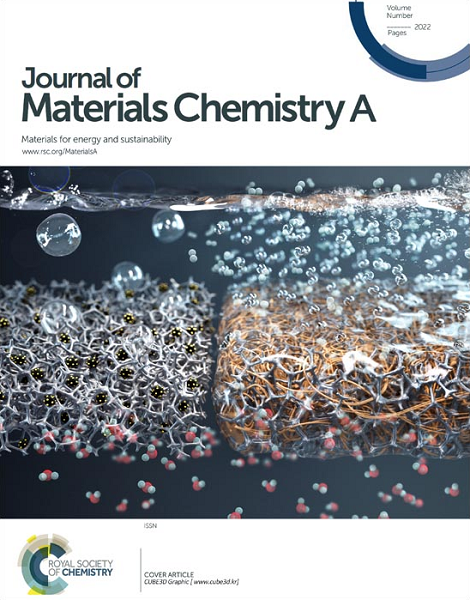利用合作光催化技术同时生产太阳能燃料和增值化学品:以无金属卟啉为基础的聚合物网络为媒介
IF 10.7
2区 材料科学
Q1 CHEMISTRY, PHYSICAL
引用次数: 0
摘要
传统的高能耗蒽醌氧化法生产 H2O2 的局限性促使研究人员提出了一种环境可持续、高能效和低成本的方法。光催化分子氧生成 H2O2 已成为可持续技术发展的一个前沿领域,但效率仍然是一个关键挑战。为了提高效率,人们在反应介质中添加了各种牺牲剂,但这些牺牲剂未得到充分利用是人们最关心的问题。为了解决这个问题,我们需要设计一种反应系统,在考虑氧气还原的同时考虑牺牲剂的选择性氧化。在这方面,我们构建了一种无金属有机聚合物 Porp-Tz,它具有宽广的可见光吸收能力和合适的波段位置,可高效还原氧气,从而共同产生 H2O2,其生成率高达 25.13 mmol g-1h-1,并可合成工业上重要的化学品 N-亚苄基苄胺(420 纳米波长下的 AQY = 7.9%)。此外,还探索了从四氢异喹啉(THIQs)同时生成具有区域选择性的 3,4-二氢异喹啉(DHIQs),H2O2 生成速率为 13.34 mmol g-1h-1。此外,光催化反应机理突出了活性氧(O2.- 和 1O2¬)、h+ 和质子供体的协同作用,为全面了解光催化过程提供了依据。这项研究强调了将下一代多功能聚合物网络用于光催化联合生产太阳能燃料和选择性合成高附加值精细化学品的新见解,拓宽了多孔有机聚合物的应用范围,具有潜在的工业价值。本文章由计算机程序翻译,如有差异,请以英文原文为准。
Leveraging the Cooperative Photocatalysis for the Concurrent Production of Solar Fuels and Value-added Chemicals: Mediated by the Metal-free Porphyrin-based Polymeric Network
Limitations in the conventional energy-intensive anthraquinone oxidation process for H2O2 production anticipated the researchers to come up with an environmentally sustainable, energy-efficient, and cost-effective approach. The photocatalytic H2O2 generation from molecular oxygen has emerged as a leading edge in sustainable technology development, yet efficiency remains a key challenge. Various sacrificial agents are added to the reaction medium to improve efficiency, but their underutilization is the primary concern. To combat this, we need to design a reaction system that considers the selective oxidation of the sacrificial agent along with the reduction of oxygen. On that note, we constructed a metal-free organic polymer Porp-Tz exhibiting broad visible light absorption, and suitable band positions that consider the efficient reduction of O2 for the co-production of H2O2 with a remarkable generation rate of 25.13 mmol g-1h-1 along with the synthesis of industrially important chemical N-benzylidenebenzylamine (AQY = 7.9 % at 420 nm). In addition, the concurrent production of regioselective 3,4-dihydroisoquinoline (DHIQs) from tetrahydroisoquinoline (THIQs), alongside the H2O2 generation rate of 13.34 mmol g-1h-1 was also explored. Moreover, the photocatalytic reaction mechanism highlights the synergistic role of the reactive oxygen species (O2.- and 1O2¬), h+, and proton donors providing a comprehensive understanding of the photocatalytic process. This study emphasizes new insights into deploying the next-generation multifunctional polymeric network for the photocatalytic co-production of solar fuel and the selective synthesis of fine value-added chemicals broadening the scope of porous organic polymers for potential industrial interest.
求助全文
通过发布文献求助,成功后即可免费获取论文全文。
去求助
来源期刊

Journal of Materials Chemistry A
CHEMISTRY, PHYSICAL-ENERGY & FUELS
CiteScore
19.50
自引率
5.00%
发文量
1892
审稿时长
1.5 months
期刊介绍:
The Journal of Materials Chemistry A, B & C covers a wide range of high-quality studies in the field of materials chemistry, with each section focusing on specific applications of the materials studied. Journal of Materials Chemistry A emphasizes applications in energy and sustainability, including topics such as artificial photosynthesis, batteries, and fuel cells. Journal of Materials Chemistry B focuses on applications in biology and medicine, while Journal of Materials Chemistry C covers applications in optical, magnetic, and electronic devices. Example topic areas within the scope of Journal of Materials Chemistry A include catalysis, green/sustainable materials, sensors, and water treatment, among others.
 求助内容:
求助内容: 应助结果提醒方式:
应助结果提醒方式:


